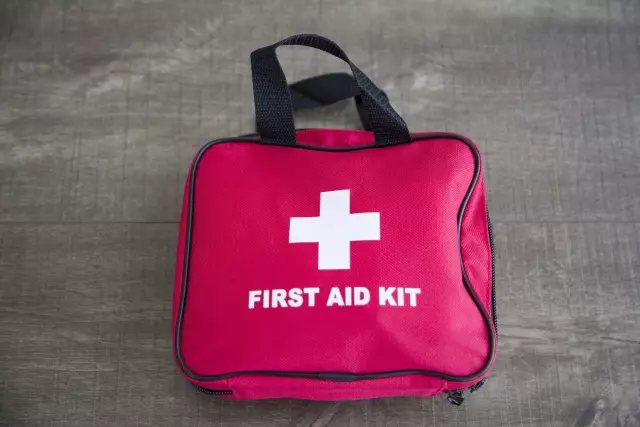- Author Curtis Blomfield [email protected].
- Public 2023-12-16 20:44.
- Last modified 2025-01-23 17:01.
When external damage to areas of human skin and tissues forms a wound. To speed up its healing without serious complications, it is necessary to apply the correct treatment to the wound. First of all, clean the debris, remove the torn edges, sew them together if necessary and apply a wound dressing. Next, consider the types of overlays, their functions and methods of application.

Types of dressings
Pads are classified according to the type of injury and how they are used.
- Soft wound dressings are designed to treat skin disorders: aseptic, bactericidal, hypertonic, protective, hemostatic.
- Fixed rigid bandages are used to fix limbs in a stable condition that are seriously injured.
- Elastic bandages are needed to treat blood stasis in the veins and their expansion.
- Wound dressings with traction of fluid accumulating in the damaged area.
- Radioactive gauze withnatural isotopes.
All soft bandages perform functions such as:
- Protection of open wounds from infections of external microflora.
- Providing isolation from getting into the wound of various chemical harmful agents and foreign bodies.
- Absorption of fluid released during wound cleaning.
- Holding various medicines in powder, ointment or liquid solution.

Aseptic dressing
Dry dressing has 3 layers of sterile gauze and an absorbent cotton pad. The width of the material should cover not only the wound, but also the area of adjacent skin areas at a distance of at least 5 cm from all sides. The cotton pad should be larger than the gauze layers in volume. Cotton wool can be replaced with an equally sterile and absorbent material - lignin. A gauze aseptic bandage without a cotton pad is applied to sutured and dry wounds.
A soft, dry dressing is needed to dry the affected area of the body, causing a scab to form on the wound. When infected, cotton-gauze dressing absorbs not only the secreted pus, but also most of the harmful microorganisms and toxins. The protective action works until the bandage is completely wet. In this case, it must be replaced immediately, otherwise the external microflora will easily penetrate the wound through the wet layers of the bandage. It can also be soaked with iodine solution and covered with a new layer of sterile gauze.

Bactericidal dressings
Antiseptic bandagesthanks to the substances contained in them, they fight harmful bacteria. In such dressings, each layer of gauze is sprinkled with a special antiseptic powder, such as streptocide.
Wet wound dressings soaked in a liquid solution are covered with a dry bandage on top, without disturbing the air ventilation. Dangerous microorganisms do not penetrate through the moist antibacterial layer. The main thing is that the bandage with an antiseptic should never be sealed. This creates a greenhouse effect under the bandage, which can lead to internal tissue burns, in particular, to necrosis.
Dressings for heavy bleeding
In order to stop venous bleeding, a bandage is used to put pressure on the wound. If this is not enough, a tourniquet is applied above the injury site or the injured limb is bent at the joint, fixing it in a bent form with a belt.
Sterile gauze is applied to an open wound and soaked in iodine solution so that the stain extends beyond the edges of the injury. Then a roll of bandages or cotton wool is tightly rolled up and applied over the bandage. It must be tied tightly by pressing on the roller with your hand. If possible, the injured limb is raised above the body. A pressure bandage is an extreme way to stop the flow of blood, since if blood circulation is disturbed, severe damage to tissues and even limbs can be caused. When using this method, it is necessary to observe the color of the fingers of the limbs. When there is a violation of the supply of blood to the tissues, the tips turn blue.

Wound healing dressings
For open woundsthere is a series of special dressings impregnated with medicinal preparations. One of the layers consists of a synthetic mesh that does not stick to the wound. This layer is impregnated with therapeutic wax or ointment containing substances that, in turn, help tissue regeneration. Thanks to the structure of the mesh layer, air circulates freely under the dressing, and the patch provides the necessary drainage and contains an absorbent layer of gauze. The mesh can be impregnated with paraffin containing medicinal preparations. The heat generated by the body softens the paraffin and releases healing medicine.
When applying a certain bandage, you should be aware of some rules for providing assistance:
- An open wound cannot be washed with water or various solutions. Washing is allowed only if toxic substances enter.
- Do not smear medicines or pour powders on the inside of the wound - this impairs tissue healing.
- Dirty that has got on the damaged area should be removed from the wound to the edges, then out.
- The areas around the wound are treated with iodine solution, but in no case should the solution be allowed to get inside.
- Blood clots formed in the wound should not be removed. This may restart the bleeding.
After stopping the blood and applying a bandage, to avoid complications, you should immediately consult a doctor.






